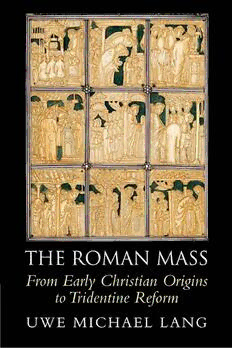Table Of ContentThe Roman Mass
Thisvolumeoffersanew,syntheticoverviewofthestructureandritual
shapeoftheRomanMassfromitsformativeperiodinlateantiquityto
its post-Tridentine standardisation. Starting with the Last Supper and
the origins of the Eucharist, Uwe Michael Lang constructs a narrative
thatexploresthe intensereligious,social, andculturaltransformations
that shaped the Roman Mass. Lang unites classical liturgical history
withinsightsfromavarietyofotherdisciplinesthathavedrawnatten-
tion to the ritual performance and reception of the mass. He also
presentsliturgicaldevelopmentswithinthebroaderhistoricalandtheo-
logical contexts that affected the celebration and experience of the
sacramental rite that is still at the heart of Catholic Christianity.
Aimedatscholarsfromabroadswatheofsubjects,includingreligious
studies,history,arthistory,literatureandmusic,Lang’svolumeserves
as a comprehensive history of the Roman Mass over the course of a
millennium.
Uwe Michael Lang is an adjunct faculty member at the Institute of
Theology and Liberal Arts at St Mary’s University, Twickenham and
Allen Hall Seminary. A priest of the Oratory of St Philip Neri in
London,heistheauthor ofTurningtowardstheLord:Orientationin
Liturgical Prayer (Ignatius Press, 2005) and Signs of the Holy One:
Liturgy,RitualandExpressionoftheSacred(IgnatiusPress,2015).He
istheeditorofAntiphon:AJournalforLiturgicalRenewal.
The Roman Mass
From Early Christian Origins to Tridentine Reform
UWE MICHAEL LANG
StMary’sUniversity,Twickenham
UniversityPrintingHouse,Cambridgecb28bs,UnitedKingdom
OneLibertyPlaza,20thFloor,NewYork,ny10006,USA
477WilliamstownRoad,PortMelbourne,vic3207,Australia
314–321,3rdFloor,Plot3,SplendorForum,JasolaDistrictCentre,
NewDelhi–110025,India
103PenangRoad,#05-06/07,VisioncrestCommercial,Singapore238467
CambridgeUniversityPressispartoftheUniversityofCambridge.
ItfurtherstheUniversity’smissionbydisseminatingknowledgeinthepursuitof
education,learning,andresearchatthehighestinternationallevelsofexcellence.
www.cambridge.org
Informationonthistitle:www.cambridge.org/9781108832458
doi:10.1017/9781108957908
©CambridgeUniversityPress2022
Thispublicationisincopyright.Subjecttostatutoryexception
andtotheprovisionsofrelevantcollectivelicensingagreements,
noreproductionofanypartmaytakeplacewithoutthewritten
permissionofCambridgeUniversityPress.
Firstpublished2022
PrintedintheUnitedKingdombyTJBooksLimited,PadstowCornwall
AcataloguerecordforthispublicationisavailablefromtheBritishLibrary.
LibraryofCongressCataloging-in-PublicationData
names:Lang,UweMichael,1972–author.
title:TheRomanmass:fromearlyChristianoriginstoTridentinereform/
UweMichaelLang.
description:Firstedition.|Cambridge;NewYork,NY:CambridgeUniversityPress,
2022.|Includesbibliographicalreferencesandindex.
identifiers:lccn2021061952(print)|lccn2021061953(ebook)|
isbn9781108832458(hardback)|isbn9781108958455(paperback)|
isbn9781108957908(epub)
subjects:lcsh:Mass–History.|Lord’sSupper–CatholicChurch–History.|
CatholicChurch–Liturgy.|BISAC:RELIGION/ChristianChurch/History
classification:lccbx2230.5.l362022(print)|lccbx2230.5(ebook)|
DDC234/.163–dc23/eng/20220316
LCrecordavailableathttps://lccn.loc.gov/2021061952
LCebookrecordavailableathttps://lccn.loc.gov/2021061953
isbn978-1-108-83245-8Hardback
Additionalresourcesforthispublicationatwww.cambridge.org/RomanMass23
CambridgeUniversityPresshasnoresponsibilityforthepersistenceoraccuracy
ofURLsforexternalorthird-partyinternetwebsitesreferredtointhispublication
anddoesnotguaranteethatanycontentonsuchwebsitesis,orwillremain,
accurateorappropriate.
Contents
List of Figures page viii
Acknowledgements ix
List of Abbreviations xi
Introduction 1
1 The Last Supper 7
The Searchfor Eucharistic Origins 7
The Date and Character of the Last Supper 12
The Wordsof Institution 20
The Bread ofLifeDiscourseof John 6 33
Conclusion 36
2 The Eucharist inthe Early Church 37
The Temple Contextof the Early Christian Eucharist 38
Sources for Early Christian Liturgy 47
Material Settings 67
Conclusion 76
3 Development of EucharisticPrayers inthe Thirdand
FourthCentury 78
Early Eucharistic Prayers: AnAtmosphereof
‘Controlled Freedom’ 78
After Constantine: Antioch and Alexandria as
LiturgicalCentres 94
Other Liturgical Developments 101
Conclusion 103
v
vi Contents
4 The Formative Period of LatinLiturgy 104
A Christian LatinCulture 104
The Canon of theMass 110
Possible Antecedents of the Roman EucharisticPrayer 125
Rhetoric of Salvation 129
Conclusion 143
Appendix: Ambrose’s Eucharistic Prayer and the
CanonMissae 145
5 Roman StationalLiturgy 154
Pontificaland Presbyteral Celebrations 154
LiturgicalBooks 156
Stational Liturgy According to Ordo RomanusI 169
The Role of Chant in the Mass 173
Particular Questions Relating to thePapal
Stational Liturgy 191
The Direction of Liturgical Prayer in Roman Basilicas 204
Conclusion 212
6 The Expansion and Adaptation of the Roman Liturgy
inthe Carolingian Age 214
Expansion of Roman Liturgical Practice 214
The Mass in Merovingian Gaul 217
The Rise oftheCarolingian Dynasty and
LiturgicalPatronage 219
Church Reformin the Age of Charlemagne 223
Personal and Emotive LiturgicalExpression 234
Raising the Level of Latinity 246
LocalReformand Practical Reach 249
Eastand West 252
Conclusion 254
7 Fromthe Ottonian Revival to the High Middle Ages 256
Fromthe Carolingian to theOttonianAge 256
The Ordo Missae 257
The Romano-GermanicPontifical and the
Ottonian Church 268
The Reform Papacy and the Roman Liturgy 275
The Papal Chapel and the Franciscan Liturgy inthe
Thirteenth Century 281
ThePlenaryMissalandtheExpansionofPrivateMasses 288
Contents vii
Veneration and Reservation ofthe Eucharist 295
Preaching at Mass 302
Conclusion 305
8 DeclineandVitality inthe Later MiddleAges 307
The Autumn of the MiddleAges? 308
Religion asa System ofSymbols 311
PopularParticipation 313
Unity and Diversity inthe Development oftheMissal 322
Codification ofRitual 327
The Massand Sacred Polyphony 335
Transformations inChurch Architecture 338
Conclusion 341
9 The Tridentine Reform 343
LiturgicalLife on the Eve of Trent 343
The Council of Trent 345
TheMissale Romanumof 1570 349
The Shape ofthe‘Tridentine Mass’ 354
Reservation of the Eucharist and Church Architecture 357
Sacred Music 362
Conclusion 364
Appendix: TheOrdinariumMissaeof the 1570
MissaleRomanum 367
Epilogue 391
Bibliography 393
Index 438
Figures
Colorversionsavailableatwww.cambridge.org/RomanMass23(password:
LangRM23)
3.1 P. Monts. Roca inv. 154b, the first page of the
Barcelona Anaphora /fourth century page 92
4.1 Bobbio Missal/c. 700 116
4.2 Mosaic panel /Sant’Apollinare in Classe, Ravenna /
seventhcentury 130
5.1 Depiction of asolemn pontifical Mass at the Sanctus /
Ivory, Lorraine /c. 875 211
6.1 Sacramentary of Hildoard of Cambrai /Northern France /
811–812 227
6.2 Drogo Sacramentary /Metz /c. 850 242
7.1 Simone Martini/ The Miraculous Mass of St Martin /
c. 1325 298
8.1 Hans BaldungGrien /The Third Commandment / 1516 320
8.2 Processionalof Sarum Use, adapted forthe Diocese
of Norwich /The blessing ofholywater on Sunday /
Latefourteenth or early fifteenth century 331
8.3 RogiervanderWeyden /Seven Sacraments Altarpiece/
c. 1445–1450 340
9.1 MissaleRomanum /1570 352
9.2 San Fedele, Milan / Commissioned in1569 361
viii
Acknowledgements
The planforthis work goesbackto aliturgy coursebook Iwrote forthe
Maryvale Institute, Birmingham, in 2013. My thoughts progressed espe-
cially when I had the welcome opportunity to teach a course on the
history of the Eucharist at two summer sessions of the Liturgical
Institute at Mundelein, Illinois, in 2014 and 2019. The material on the
first eight centuries also developed as I was teaching a module on early
Christian worship at Heythrop College, University of London, in 2017.
At various conferences and seminars, I had the occasion to test my ideas
before sympathetic and critical audiences.
Most ofthewritingwasinfact doneduring theCOVID-19pandemic
in2020and2021.Beinggiventheopportunitytoconcentrateonthiswas
the proverbial silver lining to this dark period. Without the wealth of
online resources that are now available to scholars, I could not have
completed this book. Among the libraries and other institutions whose
servicesIgratefullyused,specialthanksareduetotheBodleianLibraries,
Oxford, for their electronic document delivery. I also relied on the effi-
cient assistance of the British Library and of Heythrop Library at the
London JesuitCentre.
There are many debts to friends and colleagues for their support,
advice and constructive criticism. In a list that is far from complete,
I should like to mention Helmut Hoping, Mgr Stefan Heid, Fr Innocent
Smith OP, Hans-Jürgen Feulner, Fr Daniel Cardó, Fr Gabriel Diaz Patri,
Fr Sven Conrad FSSP, Nigel Morgan, Tessa Webber, Gabriela Signori,
JörgBölling,AdenKumlerandMatthiasSimperl.Iamparticularlygrate-
ful to those who have helped me in preparing the manuscript for
ix
x Acknowledgements
publication, Fr Martin Stamnestrø and especially Br Joseph Rodrigues
whose assistance has been invaluable.
Last but not least, I would like to thank the editorial team at
Cambridge University Press, especially Beatrice Rehl, for their support
andprofessionalismin seeing thisproject through.

